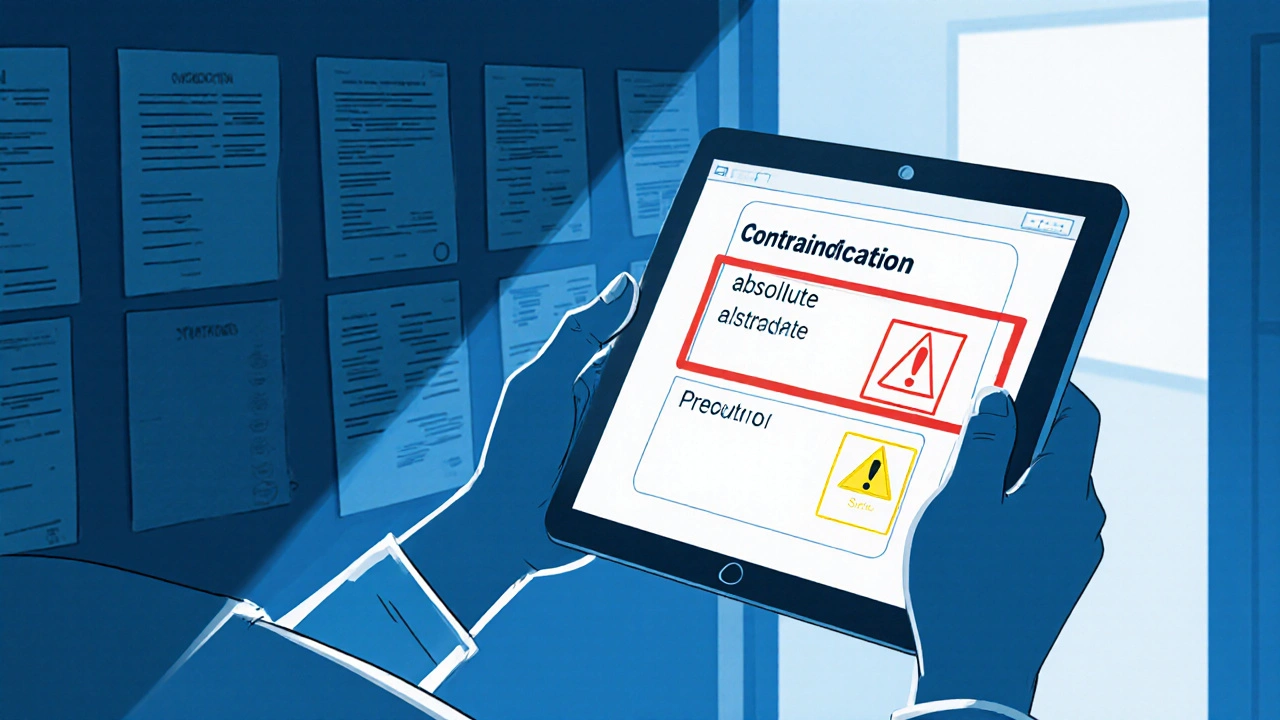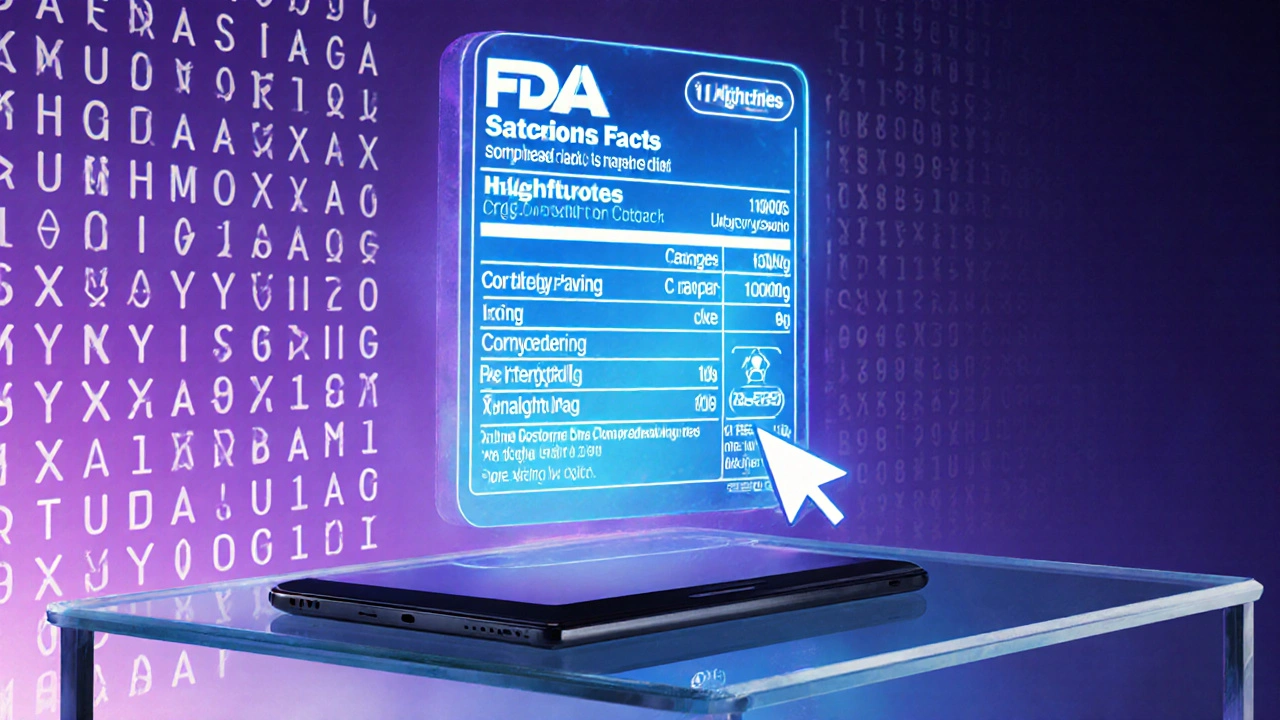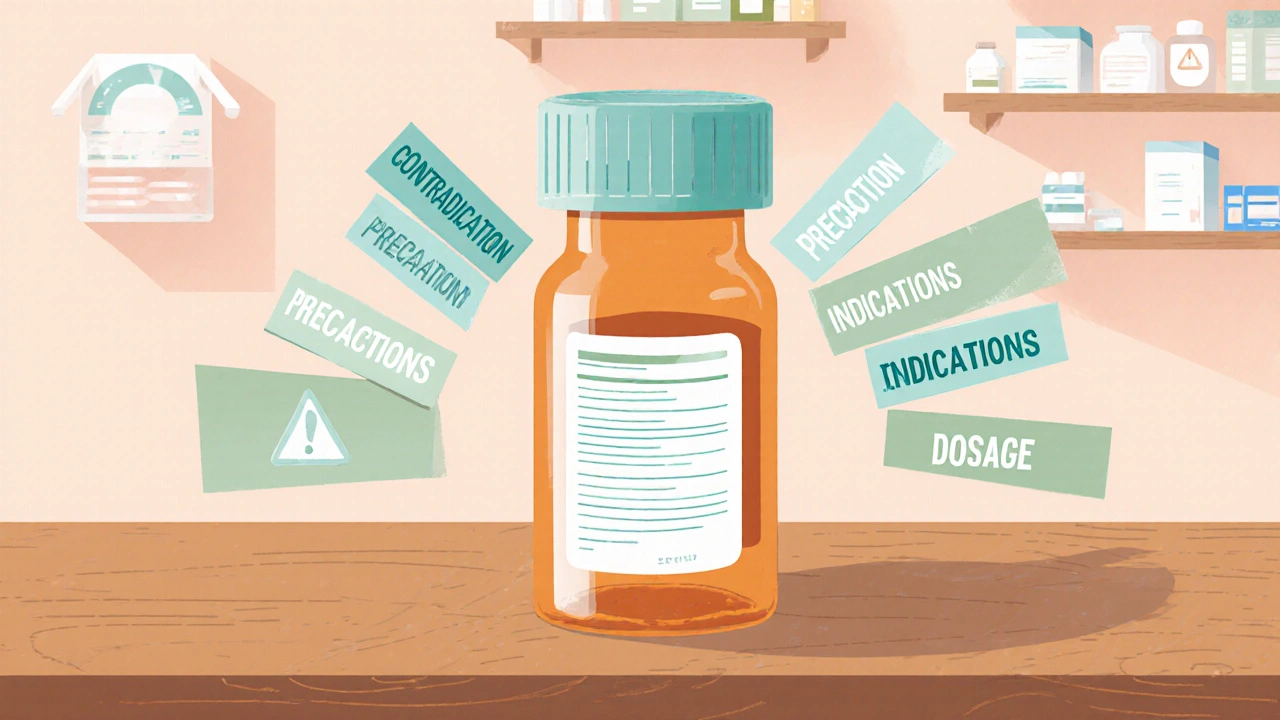FDA Label Term Comparison Tool
Compare FDA Label Terms
FDA Label Term Comparison
| Term | Placement in Label | Regulatory Citation | Typical Example |
|---|
When you pick up a prescription bottle or read an electronic label, the words you see aren’t random - they follow a strict FDA roadmap. Knowing what each term means can save a clinician time, help a pharmacist avoid errors, and empower patients to ask the right questions. Below is a practical glossary that walks you through the most common label sections, from contraindication to precaution, with real‑world examples and the regulatory citations that keep the system honest.
What the FDA Calls a "Label"
FDA label terms are a standardized set of headings, definitions, and formatting rules that appear on every approved human drug or biologic label in the United States. These terms are codified in 21 CFR 314.70 for drugs and 21 CFR 601.12 for biologics, and they live in the Structured Product Labeling (SPL) XML format mandated by the FDAAA of 2007. The SPL file feeds the searchable Drugs@FDA database, the FDA’s MedWatch alerts, and the electronic health‑record decision support tools you see in clinics.
Contraindication - When Not to Use a Drug
Contraindication is defined by the FDA as a specific situation in which the drug should not be used because it may be harmful to the patient. It appears right after the Indications and Usage section and before Warnings and Precautions. There are two flavors:
- Absolute contraindication - the drug must never be given (e.g., active pathological bleeding for Xarelto).
- Relative contraindication - use only after weighing risks and benefits (e.g., severe renal impairment for certain NSAIDs).
The regulation 21 CFR 201.57(c)(2) demands that contraindications be concise, meaningful, and free from trivial risks. In practice, they show up in the Highlights box so clinicians can spot them in seconds.
Precaution - Managing Risks When the Drug Is Used
Precaution combines the Warnings and Precautions section in modern labeling, covering serious adverse reactions, safety hazards, and steps to reduce risk. The FDA requires a clear risk statement, supporting clinical evidence, and mitigation strategies for each highlighted concern. Boxed warnings-those bold black borders-appear when there’s reasonable evidence of a causal link to a serious adverse reaction. Roughly one‑third of new molecular entities approved between 2020‑2023 carry a boxed warning.
Example: Trulicity’s label warns about thyroid C‑cell tumors and instructs providers not to prescribe it to patients with a personal or family history of medullary thyroid carcinoma. That single precaution can change a treatment plan instantly.
Indications and Usage - What the Drug Is Approved For
Indications and Usage states the specific disease or condition the drug is approved to treat, the patient population, and the intended therapeutic goal. The FDA ties this to 21 CFR 201.56(b)(1) and requires evidence from adequate and well‑controlled investigations (21 CFR 314.126). Modern labels often include biomarker requirements, reflecting the push toward precision medicine.
Take Opdivo as an example: its label reads, “treatment of patients with unresectable or metastatic melanoma, alone or with ipilimumab.” That precise language guides oncologists and insurance reviewers alike.

Dosage and Administration - How to Give the Drug
Dosage and Administration provides step‑by‑step directions on dose, frequency, route, and adjustments for special populations. 21 CFR 201.57(d) mandates clarity and conciseness, especially for geriatric, pediatric, and hepatic‑impaired patients.
Keytruda’s label, for instance, offers two dosing options-200 mg every 3 weeks or 400 mg every 6 weeks-plus detailed modification instructions if severe immune‑related adverse events occur. The FDA’s emphasis on flexible regimens reflects evolving clinical data.
Drug Interactions - When One Drug Affects Another
Drug Interactions describe situations where a drug changes the activity of another drug, supplement, food, or beverage, potentially altering efficacy or safety. The requirement lives in 21 CFR 201.57(f). Manufacturers must include clinically significant interactions demonstrated in controlled studies or post‑marketing experience.
The Eliquis label warns that strong dual inhibitors of CYP3A4 and P‑gp-like ketoconazole-raise apixaban exposure and should be avoided. That single line can prevent a dangerous bleed.
Patient Counseling Information - Bridging Provider Talk and Patient Action
Patient Counseling Information gives clinicians a ready‑made script of what to tell patients about safe use, side‑effects to watch for, and proper storage. It’s required by 21 CFR 208.20‑208.26 for Medication Guides and by 21 CFR 201.56(b)(9) for the broader counseling section.
In the Jardiance label, pharmacists are prompted to advise patients to report genital yeast infections, increased thirst, or signs of ketoacidosis immediately. The FDA’s 2022 survey showed that only 41 % of patients actually receive this counseling, highlighting a gap the section hopes to close.

Description - The Chemical Snapshot
Description offers a brief summary of the drug substance, including the chemical name, structural formula, and any stereochemistry. 21 CFR 201.56(b)(2) requires this information to be scientifically accurate. For biologics, the description often reads “recombinant human IgG1 monoclonal antibody” plus molecular weight.
Humira’s label lists its active ingredient as adalimumab, a fully human IgG1 monoclonal antibody with a molecular weight of 148 kDa. That level of detail lets chemists and regulators verify product identity.
Putting It All Together - A Quick Reference Table
| Term | Placement in Label | Regulatory Citation | Typical Example |
|---|---|---|---|
| Contraindication | After Indications, before Warnings | 21 CFR 201.57(c)(2) | Active pathological bleeding (Xarelto) |
| Precaution | Warnings & Precautions section | 21 CFR 201.57(c) | Thyroid C‑cell tumor risk (Trulicity) |
| Indications and Usage | First substantive section | 21 CFR 201.56(b)(1) | Unresectable melanoma (Opdivo) |
| Dosage and Administration | After Indications, before Drug Interactions | 21 CFR 201.57(d) | 200 mg q3w or 400 mg q6w (Keytruda) |
| Drug Interactions | After Dosage section | 21 CFR 201.57(f) | Avoid strong CYP3A4 inhibitors (Eliquis) |
| Patient Counseling Info | Separate counseling section or Medication Guide | 21 CFR 208.20‑208.26 | Report genital yeast infection (Jardiance) |
| Description | Highlights and Full Label | 21 CFR 201.56(b)(2) | Recombinant IgG1 mAb (Humira) |
Common Pitfalls and Pro Tips
- Don’t skim the Highlights. The FDA forces the most critical safety info-contraindications, boxed warnings, and dosing changes-into this box.
- Watch for updates. About 97 % of label changes from 2015‑2020 were Category 2 updates (post‑marketing safety data). Check Drugs@FDA regularly.
- Use the SPL XML. If you pull the label programmatically, you’ll get machine‑readable fields for each term, which can be fed into clinical decision support tools.
- Ask the pharmacy. When a term looks ambiguous (e.g., “relative contraindication”), a quick call can clarify if the risk is truly manageable for a specific patient.
Looking Ahead - Digital Labeling in 2026
The FDA’s “Labeling for the Digital Age” initiative promises standardized section numbering and smarter search within the Drugs@FDA portal by the end of 2026. Interactive elements-like expandable risk summaries-are already being piloted for Q2 2025. Until then, the best way to stay current is to subscribe to the FDA’s monthly labeling updates and to integrate the SPL feeds into your pharmacy information system.
What’s the difference between a contraindication and a precaution?
A contraindication tells you when NOT to give a drug at all, while a precaution outlines steps to reduce risk when the drug is used. Contraindications are absolute or relative; precautions often include monitoring or dose‑adjustment advice.
Where can I find the most up‑to‑date FDA label for a medication?
Visit the Drugs@FDA database and search by brand or generic name. The site provides the latest Structured Product Labeling (SPL) file, which is the official, current label.
How often do label sections change after a drug is approved?
Between 2015‑2020, 97 % of changes were Category‑2 updates, which typically involve safety information like new contraindications or dosing adjustments. The FDA releases a quarterly post‑marketing labeling report summarizing these changes.
Do over‑the‑counter (OTC) products use the same label format?
OTC labels follow a similar structure but are governed by different sections of the FD&C Act (21 CFR 211). They still include indications, dosage, warnings, and active ingredient description, but the wording is written for a lay audience.
Can I rely on the patient counseling section for teaching patients?
Yes. The FDA designs that section to be clear and actionable. It’s a good starting point, but you should tailor the conversation to the patient’s health literacy level and cultural background.


junior garcia
October 24, 2025 AT 13:44Wow, this glossary is like a survival guide for anyone handling prescriptions – clear, precise, and absolutely essential!
Kester Strahan
October 25, 2025 AT 03:37Totally agree, the way they break down contraindications vs precautions is spot on – it’s basically the pharma‑speak bible. The citations to 21 CFR make it legit, even if the wording feels a bit dense for newbies.
Doreen Collins
October 25, 2025 AT 17:30I love how this post highlights the need to actually read the Highlights box – so many clinicians skim and miss a critical warning. It’s a solid reminder that the “quick glance” can be dangerous if you don’t know what to look for. Keep pushing these best‑practice tips!
HILDA GONZALEZ SARAVIA
October 26, 2025 AT 06:24One of the most valuable aspects of understanding FDA label terminology is how it directly influences clinical decision‑making across the care continuum. When you see a boxed warning, that’s not just a decorative black border; it signals a level of risk that demands immediate attention and often alters prescribing pathways. Contraindications, whether absolute or relative, serve as a gatekeeper – they tell you when a drug should never be administered versus when you need a nuanced risk‑benefit discussion. For instance, the absolute contraindication for Xarelto in active pathological bleeding eliminates any therapeutic consideration, whereas the relative contraindication for severe renal impairment with certain NSAIDs forces a dosage adjustment or alternative therapy. Precautions go a step further by providing actionable steps – like mandated monitoring labs or dose titration protocols – that mitigate potential adverse events while still allowing the medication’s benefits. The regulatory backbone, enshrined in sections like 21 CFR 201.57(c)(2) and 21 CFR 201.57(f), ensures that manufacturers present this information consistently, which is vital for electronic health record decision‑support algorithms. Pulling the Structured Product Labeling (SPL) XML files lets informatics teams flag new safety updates automatically, reducing the lag between label change and clinician awareness. Moreover, the patient counseling section translates these technical nuances into lay language that pharmacists can use at the point of dispense, closing the communication loop. Studies have shown that when counseling is omitted, medication errors double, underscoring the real‑world impact of these seemingly dry sections. In practice, I’ve seen how a clear contraindication note prevented a catastrophic bleed in a patient on anticoagulants who also required an urgent procedure. Conversely, vague language can leave clinicians guessing, which is why the FDA emphasizes concise, unambiguous phrasing. The move toward digital labeling by 2026 promises even richer interactivity – think expandable risk summaries that can be embedded directly into order sets. Until then, staying vigilant by regularly checking Drugs@FDA for Category‑2 updates is the best defense against unexpected label changes. Finally, remember that OTC products, while following a lighter format, still contain crucial warnings; ignoring them can be just as perilous. All in all, mastering this glossary equips every healthcare professional with a powerful tool to enhance safety and efficacy.
Amanda Vallery
October 26, 2025 AT 20:17Actually, the FDA’s requirement for a concise risk statement isn’t just bureaucratic fluff – it’s a safety net that protects both patients and prescribers.
Marilyn Pientka
October 27, 2025 AT 10:10Frankly, anyone who thinks the “patient counseling” section is optional is demonstrating a blatant disregard for regulatory rigor and public health ethics. The FDA mandates these sections to bridge the gap between complex pharmacology and lay understanding; skipping them is an affront to the standards we uphold.
Jordan Levine
October 28, 2025 AT 00:04📢 This info is gold for America’s drug safety! 🇺🇸
Carla Taylor
October 28, 2025 AT 13:57Love how this breaks down the jargon – makes it so much easier to explain to patients and stay on top of updates.